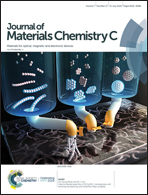In situ encapsulation of pyridine-substituted tetraphenylethene cations in metal–organic framework for the detection of antibiotics in aqueous medium†
Abstract
Antibiotics have become a pollutant in water due to their abuse, which poses a threat to the environment and human health. An urgent and meaningful task is to develop highly sensitive and selective sensors. Herein, a new and simple luminescent MOF [Zn8(C5H4N5)4(C14H8O4)6O(C50H44N4)0.5] (TMPyPE@bio-MOF-1) was synthesized by in situ encapsulation of cationic TPE-based guest TMPyPE into an anionic MOF. TMPyPE@bio-MOF-1 exhibits high stability and strong fluorescence in water, and can selectively and sensitively detect nitrofuran antibiotics in aqueous medium. At the same titration concentration, TMPyPE@bio-MOF-1 shows higher fluorescence quenching efficiencies of 96% for NFZ and 95.5% for NFT compared with other antibiotics, which can be detected by the naked eye. Due to the simplicity and sensitivity of analysis, the tetraphenylethene-based luminogen encapsulated LMOF material reported would have wide application potential in environmental pollution analysis.



 Please wait while we load your content...
Please wait while we load your content...